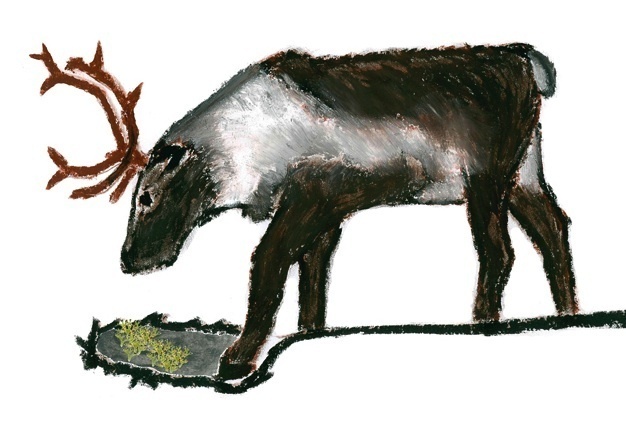While skiing, snowshoeing, and dog mushing in Denali National Park, caribou tracks often crisscross our human paths. Every now and again the caribou tracks are interrupted by a hole dug to the ground with the snow flung nearby. These holes can be 2-12 inches deep and 1-6 feet in diameter. Woe to the fast moving human snow traveler who encounters a large “crater” in their path.
Caribou dig through snow to find food, a process that leaves behind craters of various sizes and to the human observer in seemingly random locations, including on well-packed ski and dog mushing trails. The name caribou comes, through French, from Mi’kmaq qalipu, meaning, "snow shoveler". The caribou in Denali National Park are recognized as Rangifer tarandus by modern day scientists.
The Mi’kmaq, First Nations people of the Canadian Maritime Provinces, watched caribou move large quantities of snow. They shovel the snow with their hooves usually to ground level to find lichens, dried willow and birch leaves, sedges, grasses and lingonberries. In the winter up to 70% of their diet can be lichens but not just any old lichen will do; mostly they feed on a particular genus of lichen often referred to as reindeer moss, Cladonia sp. In areas of shallow or patchy snow, it may take only a few minutes to expose enough food for the day. On the other hand, cratering may occur for more than two hours each day as caribou labor to break ice crusts or move heavy, deep snow. They are using their nose to smell the correct lichens and thus choose a place to crater.
The caribou nose was recently discovered to have a remarkable role, not in olfaction, but in thermoregulation. Caribou have specialized noses featuring nasal turbinate bones (shaped like a spinning top) that dramatically increase the surface area within the nostrils. Incoming cold air is forced over the extensive mucosa covering the turbinates and thus warmed by the animal's body heat before entering the lungs, and water is condensed from the expired air and captured before the breath is exhaled. Thus the nose helps keep caribou warm and hydrated. The newly discovered role is that the same increased surface area is used to keep caribou cool. When running from a predator or in hot weather caribou need to dissipate heat. The first defense is to pant but when the brain temperature is about to go over 102 degrees F, the blood to the brain is re-routed over those turbinate bones. The increased surface area allows the hot blood to cool before it causes brain damage. *
The amazing caribou uses its nose to stay warm during frigid winter days while creating craters for unwary snow travelers to stumble over. And it uses its nose to stay cool in the summer when fleeing from a wolf. Of course, Rudolf, that legendary reindeer used his nose for an entirely different purpose.
*Knight, Kathryn, Rudolph’s Cooling Strategy Revealed, J Exp Biol 2011 214:i. doi: 10.1242/jeb.066621
Thanks to Matthew Iverson for the sketch.




